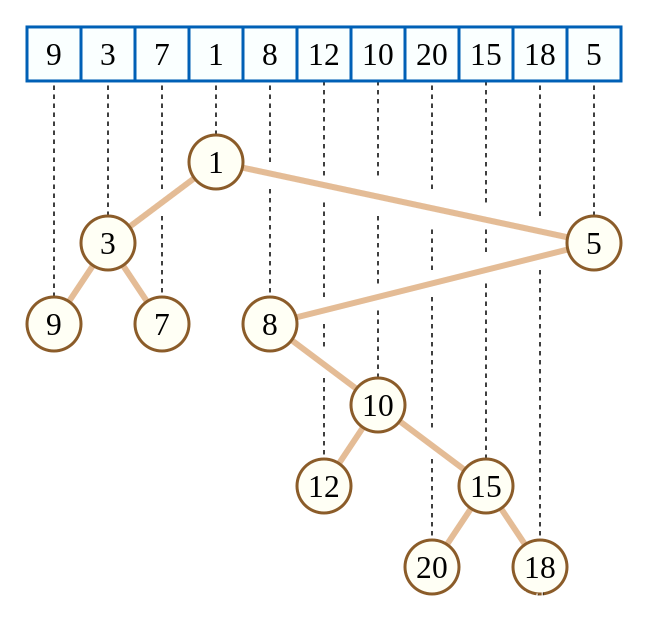目录
- 一、性质
- 二、构建笛卡尔树
- 三、应用
- 四、源码
一、性质
-
堆性质: 笛卡尔树是一种满足堆性质的树。每个节点包含两个值:键值(key)和优先级值(priority)。在笛卡尔树中,根节点的优先级值最大,且每个节点的优先级值大于其子节点的优先级值。
-
中序遍历: 笛卡尔树的中序遍历结果与原始数组的顺序一致。这意味着,如果你将笛卡尔树按中序遍历的顺序输出,就会得到原始数组的顺序。
-
唯一性: 对于给定的键值数组,存在唯一的笛卡尔树与之对应。
 (备注:图源于 维基百科)
(备注:图源于 维基百科)
二、构建笛卡尔树
- 笛卡尔树通常是通过一个数组构建的,数组中的元素按照顺序表示树中节点的键值,另一个数组表示节点的优先级值。
- 通过递归的方式构建笛卡尔树:在给定数组范围内,找到优先级值最大的元素作为根节点,然后递归构建左子树和右子树。
三、应用
-
最小公共祖先(LCA): 通过构建笛卡尔树,可以在O(1)时间内找到任意两个节点的最小公共祖先。
-
区间最小值/最大值查询: 通过构建笛卡尔树,可以在O(log n)时间内查询给定区间的最小值或最大值。
四、源码
#include <iostream>
#include <vector>using namespace std;struct Node {int key;int priority;Node* left;Node* right;Node(int k, int p) : key(k), priority(p), left(nullptr), right(nullptr) {}
};Node* buildCartesianTree(vector<int>& arr, vector<int>& priority, int start, int end) {if (start > end) {return nullptr;}int maxIndex = start;for (int i = start + 1; i <= end; i++) {if (priority[i] > priority[maxIndex]) {maxIndex = i;}}Node* root = new Node(arr[maxIndex], priority[maxIndex]);root->left = buildCartesianTree(arr, priority, start, maxIndex - 1);root->right = buildCartesianTree(arr, priority, maxIndex + 1, end);return root;
}void inOrderTraversal(Node* root) {if (root) {inOrderTraversal(root->left);cout << "(" << root->key << ", " << root->priority << ") ";inOrderTraversal(root->right);}
}int main() {vector<int> arr = { 9,3,7,1,8,12,10,20,15,18,5 };vector<int> priority = { 8,10,8,11,8,4,5,2,4,2,10 };Node* root = buildCartesianTree(arr, priority, 0, arr.size() - 1);cout << "Inorder traversal of Cartesian Tree: ";inOrderTraversal(root);cout << endl;return 0;
}-Prompt个性知识库引导)



)










——小样本学习)
(38))
)

